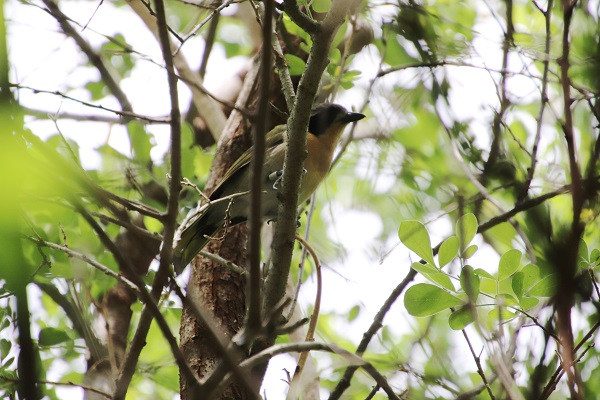Regular readers might be aware that much of our garden has been given over to indigenous forest. This makes photographing birds a challenge, given the poor light, the foliage, and an amazing number of branches and twigs that get in the way! The advantages outweigh the disadvantages though for we now see a greater variety of birds than we could have dreamed possible in the cactus-covered garden we took over thirty years ago. We even have Knysna Turacos coming down from the canopy to drink, bathe and eat fruit in full view while we are sitting outside – that is a real privilege.
The plethora of trees makes it imperative that we get to recognise the sounds birds make in order to differentiate between them, simply because they are not always visible. The African Green Pigeons, for example, have been roosting in our garden for the past couple of months and yet we rarely see them unless they happen to fly in or move while we happen to be looking at the fig tree.
For some weeks now there have been some rather harsh krrr krrr calls in the very early mornings as well as a variety of whistles that have teased my memory without taking hold. Some bird was living in or visiting my garden sans identification!
The familiar alarm calls of a pair of nesting Cape Robin-chats attracted me to the forest at the side of our house the other morning when I chanced to have my camera in hand. I eagerly scanned the canopy in the hope of seeing either a snake or a Burchell’s Coucal. I saw neither, but did hear those strange whistling sounds again. Once I had identified the source at last, I had time to snap only two photographs and the source was gone – remaining a mystery.
So, these photographs are not the best by a log chalk. They do, however, illustrate how even a ‘snap’ can be useful when viewed on the computer. I had to lighten both images to get a reasonable view of the bird and then enlarge them on the screen to make out what it was I had photographed.
That ‘mysterious’ bird is none other than an Olive Bush-Shrike (Telophorus olivaceus)! It was only by looking at the fixed image on the screen that I could make out the olive feathers and the pinkish-buff throat that had been too dark in the forest to make out with the naked eye. The large eye of the bird pointed to something out of the ordinary. A closer inspection of the second image revealed the typical shrike beak, the black mask and that this particular bird has been ringed.
Olive Bush-shrikes are near-endemic to southern Africa, particularly along the coastal regions, where their preferred habitats are woodlands and riverine forests. They mainly eat insects, foraging in the tree canopy and gleaning insects from leaves and twigs, but they are also known to eat small birds and fruit – which is probably why the nesting Robin-chats were making their frantic alarm calls.
I have recorded Grey-headed Bush-shrikes in my garden before, but this is the first Olive Bush-shrike I have positively identified – definitely a lucky break for me!



Lucky beak! I mean, break. But what does it mean to be ringed?
LikeLike
The ringing of birds provides individual identification about the bird. A unique number on each ring shows where and when the bird was caught, and a return address shows where to send information.This helps in keeping track of the movements of the bird and its life history. The collected information is useful for studying migration, for example.
LikeLike
Sjoe, jy was gelukkig om hom te sien, Anne! Altyd lekker as mens die voël kan identifiseer.
LikeLike
Ek WAS baie gelukkig!
LikeLiked by 1 person
What a lovely visitor to have. And the green pigeons too!
LikeLike
We first noticed the African Green Pigeons visiting our garden in 2004. Since then several have taken to roosting in our fig tree. These numbers swell considerably once the figs are ripe.
LikeLiked by 1 person
What a capture! 🙂
LikeLike
I was very fortunate indeed.
LikeLiked by 1 person